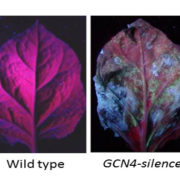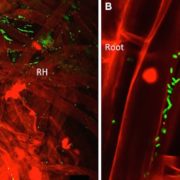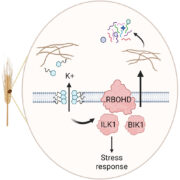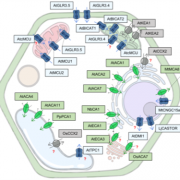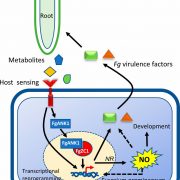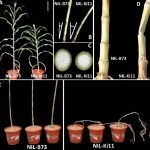Oxylipins other than jasmonic acid regulate systemic resistance (Plant Cell)
 Plant roots communicate with microbes in a sophisticated manner through chemical communication within the rhizosphere, thereby leading to biofilm formation of beneficial microbes and resulting in priming of defence, or induced resistance in the plant host to a wide range of pathogens (induced systemic resistance, ISR). Trichoderma virens is an agriculturally-relevant root-colonizing fungus that provides its plant hosts many benefits, such as increased growth, destruction of soil-borne pathogens, and enhanced ISR. The signal communication between T. virens and host plants is poorly understood; ISR induction is supposed to depend upon the phytohormones ethylene and jasmonic acid (JA), one of hundreds of oxylipins. Lipoxygenases (LOX) are key enzymes in the biosynthesis of oxylipins and in particular LOX10 was described as a positive regulator of ISR. In this paper the authors analysed the xylem sap of T. virens-treated maize in order to determine potential ISR signals, by using ISR-positive and -negative mutants of both maize and T. virens. The screening revealed that accumulation of two oxylipins, the JA precursor (12-OPDA) and α-ketol (KODA) correlated with ISR activation in a dose-dependent manner. (Summarized by Francesca Resentini) Plant Cell 10.1105/tpc.19.00487.
Plant roots communicate with microbes in a sophisticated manner through chemical communication within the rhizosphere, thereby leading to biofilm formation of beneficial microbes and resulting in priming of defence, or induced resistance in the plant host to a wide range of pathogens (induced systemic resistance, ISR). Trichoderma virens is an agriculturally-relevant root-colonizing fungus that provides its plant hosts many benefits, such as increased growth, destruction of soil-borne pathogens, and enhanced ISR. The signal communication between T. virens and host plants is poorly understood; ISR induction is supposed to depend upon the phytohormones ethylene and jasmonic acid (JA), one of hundreds of oxylipins. Lipoxygenases (LOX) are key enzymes in the biosynthesis of oxylipins and in particular LOX10 was described as a positive regulator of ISR. In this paper the authors analysed the xylem sap of T. virens-treated maize in order to determine potential ISR signals, by using ISR-positive and -negative mutants of both maize and T. virens. The screening revealed that accumulation of two oxylipins, the JA precursor (12-OPDA) and α-ketol (KODA) correlated with ISR activation in a dose-dependent manner. (Summarized by Francesca Resentini) Plant Cell 10.1105/tpc.19.00487.


